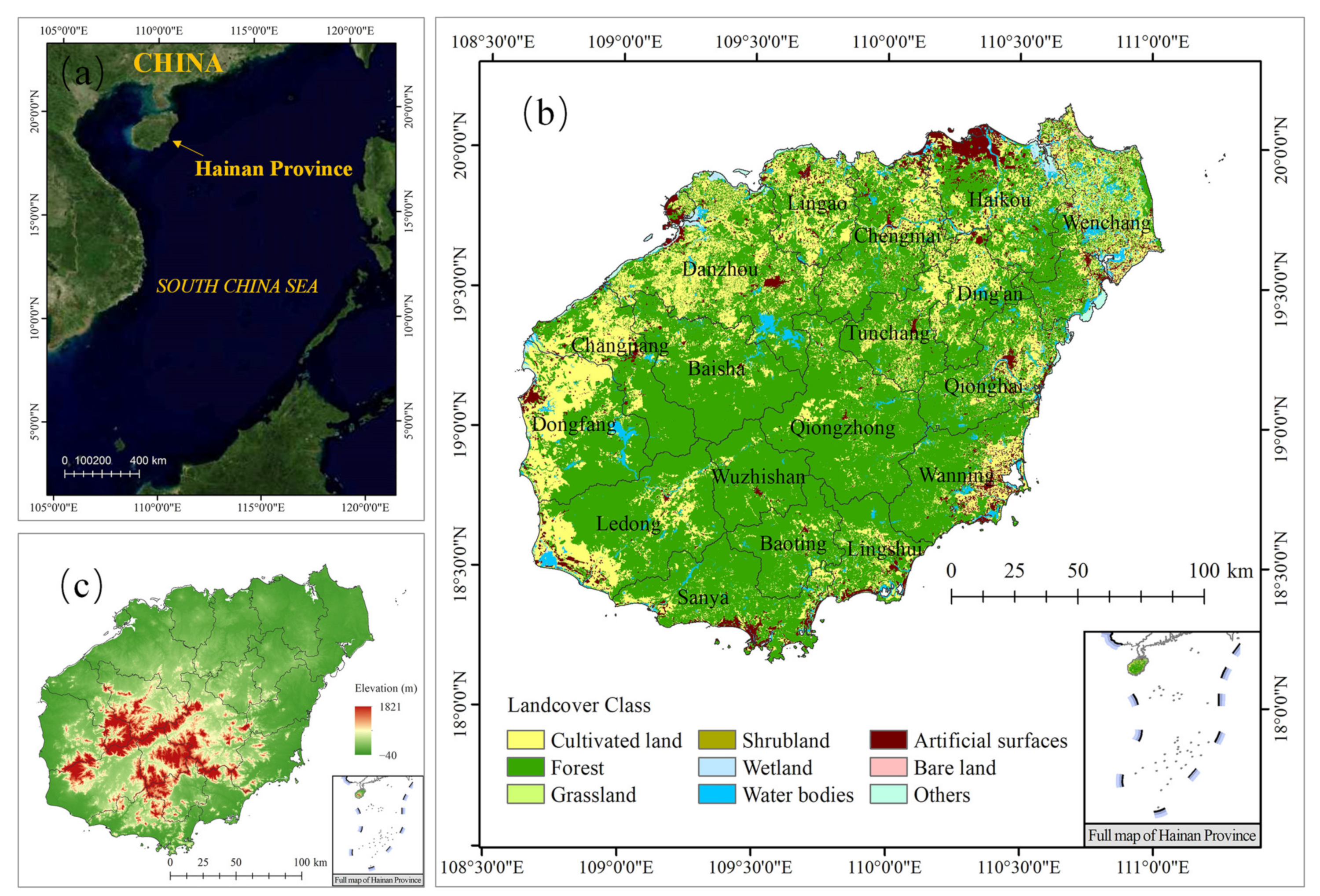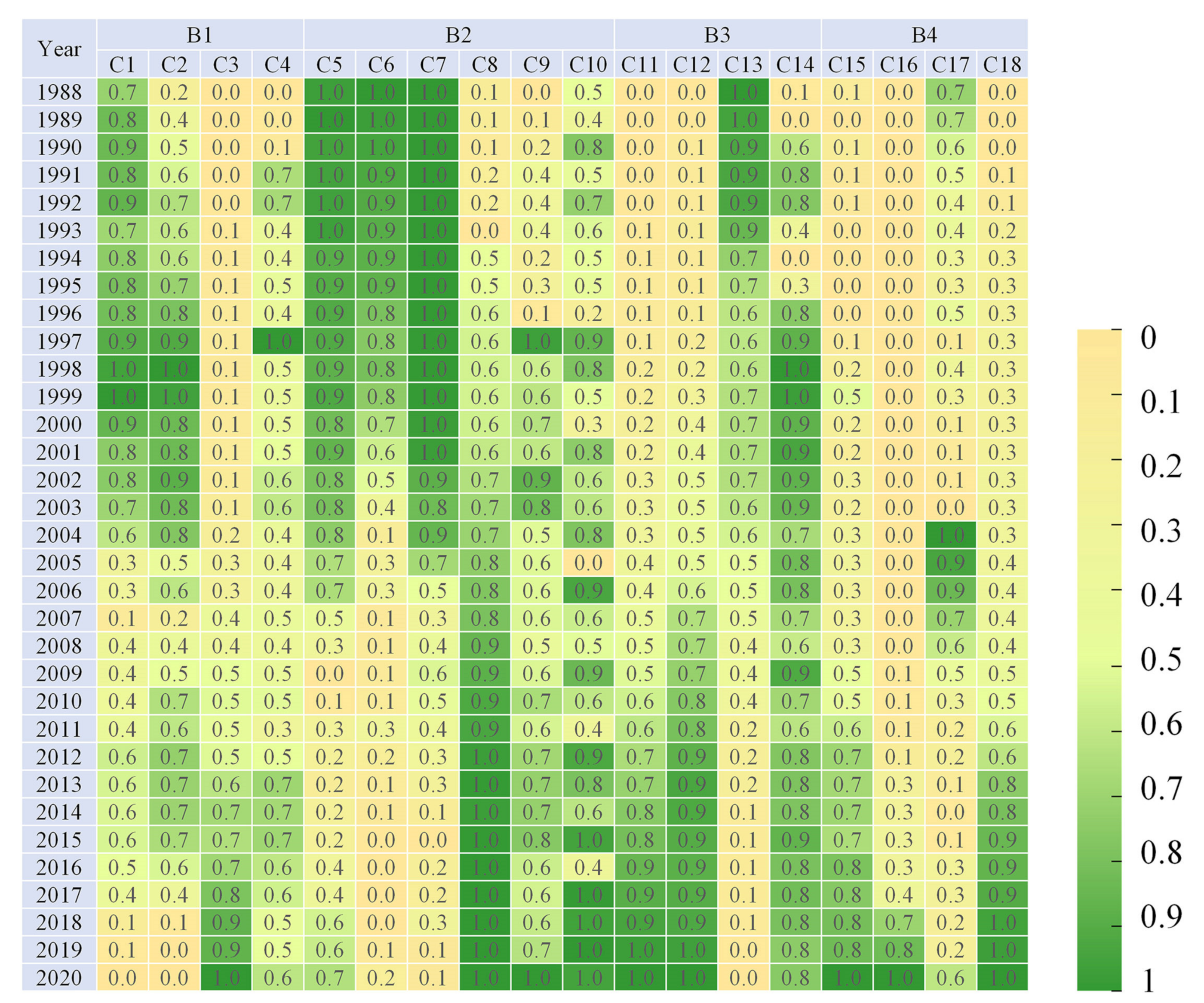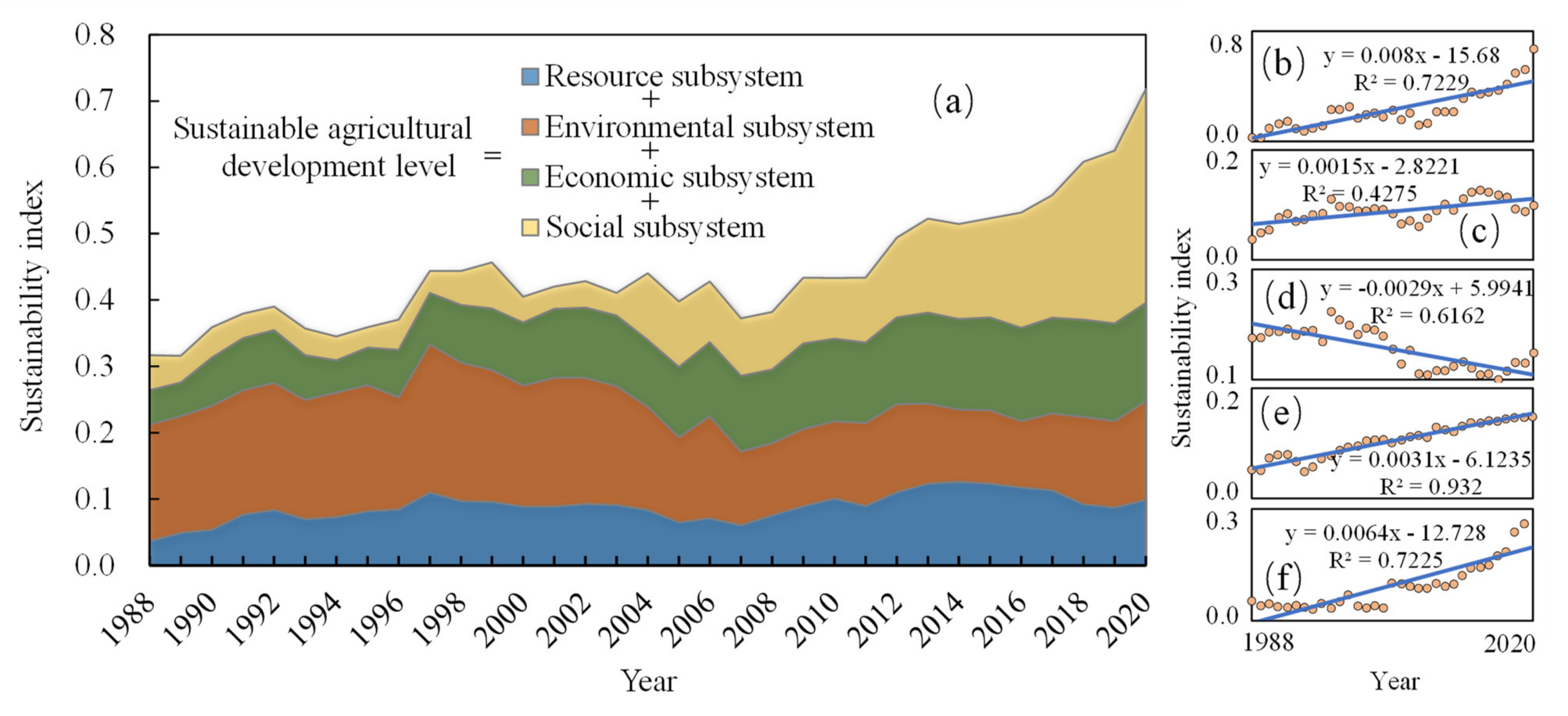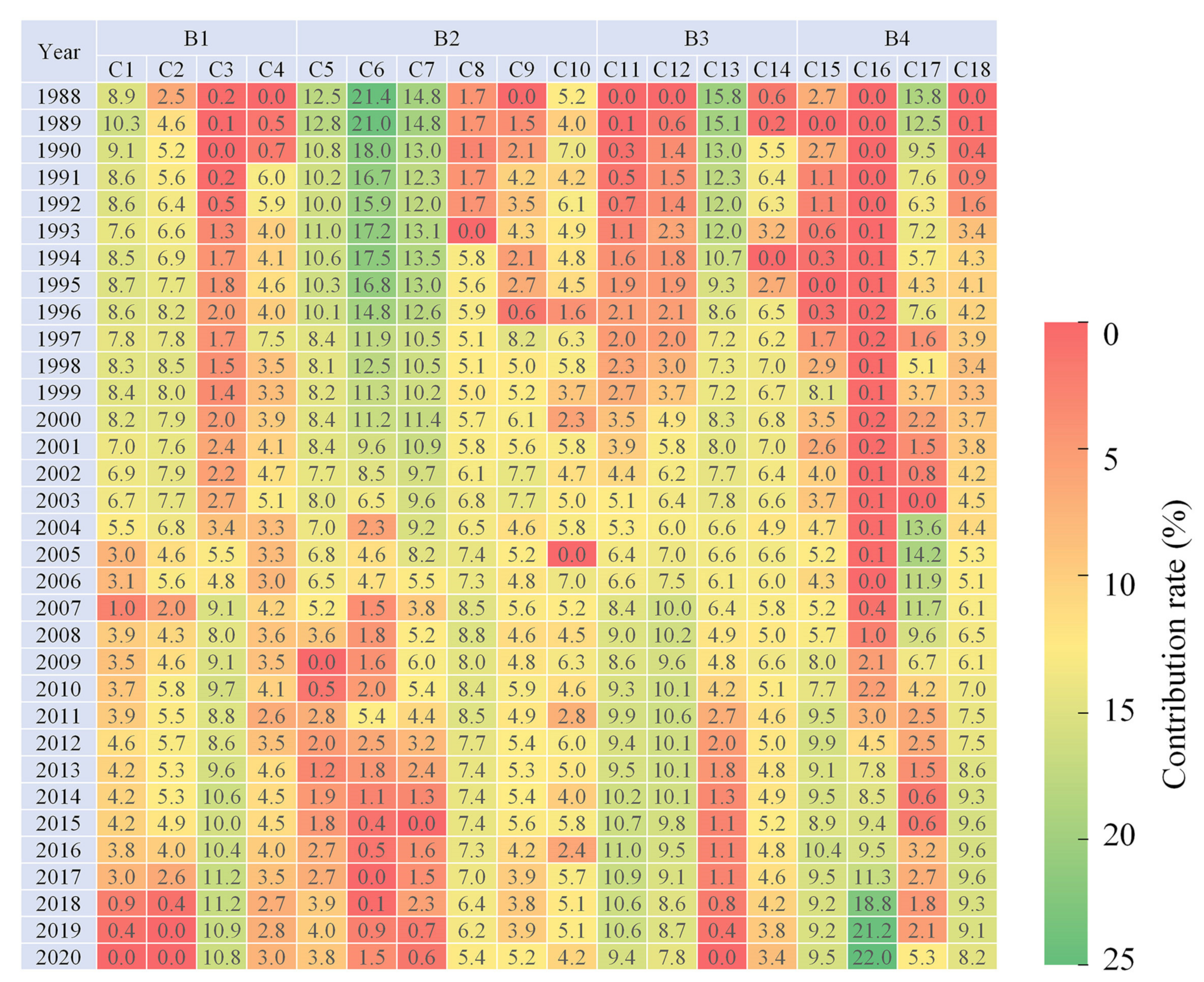Measurement Indicators and an Evaluation Approach for Assessing the Sustainable Development Capacity of Tropical Agriculture: A Case Study for Hainan Province, China
Abstract
1. Introduction
2. Materials and Methods
2.1. Study Area
2.2. Evaluation Index System for the Sustainable Development Level of Tropical Agriculture
- (1)
- Resource subsystem. As the main raw materials of agricultural production, agricultural resources are the basic natural resources that support and guarantee the ability of agricultural ecosystem development. Land resources and water resources have been irreplaceably important resources for agricultural activities since ancient times. However, the development of urbanization and industrialization has led to a continuous reduction in the area under cultivation. Multi-cropping improves grain yield to a certain extent and alleviates the contradiction between food security and economic development in Hainan. The level of agricultural mechanization is an important measure of the degree of agricultural modernization. Therefore, the per capita area of tropical agricultural land (C1), the multiple cropping index of cultivated land (C2), agricultural machinery power (C3), and the proportion of effectively irrigated areas of cultivated land (C4) were selected as indicators of the resource subsystem in this study.
- (2)
- Environmental subsystem. The protection of the agroecological environment is the fundamental basis for sustainable agricultural production. The use of chemical fertilizers, pesticides, and agricultural films not only increases crop yields but also causes agricultural non-point source pollution, which to some extent, hinders the sustainable development of agriculture. Increasing forest coverage can improve the ability of the agroecosystem to conserve water and soil and regulate the climate, especially in Hainan, where frequent typhoons are frequent. In addition, Hainan suffers from frequent tropical disasters, including droughts and typhoons, which have caused huge losses to agricultural production. Therefore, in this study, pesticide use intensity (C5), chemical fertilizer use intensity (C6), agricultural film use intensity (C7), forest coverage (C8), the proportion of the area of cultivated land to ensure stable yields in drought and waterlogging (C9), and the proportion of the disaster area of tropical agricultural land (C10) were selected as indicators of the environmental system.
- (3)
- Economic subsystem. Agricultural economic conditions are the support and guarantee of sustainable agricultural development, which can affect the sustainable development of the agricultural system by acting on the agricultural resource ecosystem and the social system. The most direct agricultural economic conditions, namely the agricultural output value and crop productivity, can directly reflect the economic benefits of the agricultural system. In addition to their own economic benefits, but also need to consider the price of agricultural means of production and rural consumer price fluctuations. The price index of agricultural means of production is a relative number that reflects the trend and degree of the price change of agricultural means of production in a given period. The rural consumer price index is a relative number that reflects the trend and degree of the price change of consumer goods and services purchased by rural households. These fluctuations have an impact on the psychology of the population. Therefore, the index of the total agricultural output value (C11), the average yield of tropical fruits and vegetables (C12), the price index of agricultural means of production (C13), and the rural consumer price index (C14) were selected as indicators of the economic system in this study.
- (4)
- Social subsystem. The harmony and stability of rural society are the prerequisite for ensuring the sustainable development of local agriculture and also the powerful embodiment of rural development. With the continuous acceleration of the modern urbanization process, the rural population structure has changed significantly. Many farmers have turned to part-time work and part-time farming or completely abandoned farming altogether, affecting the development of agriculture. Scientific and technological innovation can greatly improve the efficiency and precision of agriculture and is the core driving force and fundamental way to achieve sustainable agricultural development. The input of agricultural insurance can compensate for the losses caused by agricultural risks to a certain extent so as to stabilize the income of agricultural producers, expand the scale of ecological agricultural production, and ensure the sustainable stability of agricultural production. Therefore, the input intensity of research and development (C15), input intensity of agricultural insurance premiums (C16), the rural population density (C17), and the proportion of rural-employed persons (C18) were selected as indicators of the social system in this study.
2.3. Method of Data Standardization and Indicator Weighting
2.4. Methods for Assessing the Sustainable Development Level of Tropical Agriculture
3. Results
3.1. Comprehensive Evaluation of Sustainable Development Level of Tropical Agriculture
3.2. Spatial Pattern of Sustainability Index of Tropical Agriculture
3.3. Analysis of the Factors Influencing the Sustainability Index of Tropical Agriculture
4. Measures and Suggestions for Promoting Sustainable Development of Tropical Agriculture
4.1. Strengthening the Construction and Protection of Cultivated Land Quality
4.2. Improving the Ecological Environment of Farmland
4.3. Promoting the Innovation of Agricultural Science and Technology
4.4. Implementing Policies for the Sustainable Development of Tropical Agriculture
5. Conclusions
Author Contributions
Funding
Institutional Review Board Statement
Informed Consent Statement
Data Availability Statement
Conflicts of Interest
References
- Lian, X.; Jeong, S.; Park, C.E.; Xu, H.; Li, L.Z.; Wang, T.; Gentine, P.; Penuelas, J.; Piao, S.L. Biophysical impacts of northern vegetation changes on seasonal warming patterns. Nat. Commun. 2022, 13, 3925. [Google Scholar] [CrossRef]
- MacLeod, M.; Arp, H.P.H.; Tekman, M.B.; Jahnke, A. The global threat from plastic pollution. Science 2021, 373, 61–65. [Google Scholar] [CrossRef]
- Willemen, L.; Barger, N.N.; Brink, B.T.; Cantele, M.; Erasmus, B.F.N.; Fisher, J.L.; Gardner, T.; Holland, T.G.; Kohler, F.; Kotiaho, J.S.; et al. How to halt the global decline of lands. Nat. Sustain. 2020, 3, 164–165. [Google Scholar] [CrossRef]
- World Commission on Environment and Development (WCED). Our Common Future; Oxford University Press: Oxford, UK, 1987. [Google Scholar]
- United Nations (UN). Earth Summit Agenda 21 the United Nations Programme of Action from Rio; United Nations: New York, NY, USA, 1992. [Google Scholar]
- United Nations (UN). Transforming Our World: The 2030 Agenda for Sustainable Development; United Nations: New York, NY, USA, 2015. [Google Scholar]
- Chen, S.F.; Liu, Y.; Su, L.Y. Sustainable Agriculture in the “Belt and Road” Region in Conjunction with the Sustainable Development Goals. J. Resour. Ecol. 2019, 10, 649–656. [Google Scholar]
- Cui, P.; Zhu, A. China Tropical Agriculture Development Strategy in the New Period. Chin. J. Trop. Crops 2020, 41, 1949–1953. [Google Scholar]
- Zhai, D.L.; Xu, J.C.; Dai, Z.C.; Cannon, C.H.; Grumbine, R.E. Increasing tree cover while losing diverse natural forests in tropical Hainan, China. Reg. Environ. Chang. 2014, 14, 611–621. [Google Scholar] [CrossRef]
- Song, C.Y.; Zhang, J.J.; Liu, L.; Ma, W.Q.; Ma, L.; Ding, S.; Zhao, H.W. Spatial and temporal characteristics of agricultural green development indicators in Hainan Island. Chin. J. Eco-Agric. 2020, 28, 1156–1167. [Google Scholar]
- Shen, J.B.; Zhu, Q.C.; Jiao, X.Q.; Ying, H.; Wang, H.; Wen, X.; Xu, W.; Li, T.; Cong, W.; Liu, X.; et al. Agriculture green development: A model for China and the world. Front. Agric. Sci. Eng. 2020, 7, 5–13. [Google Scholar] [CrossRef]
- Qi, Y. A New Goal of Hainan: From Pilot Free Trade Zone to Free Trade Port with Chinese Characteristics. Stud. China’s Spec. Econ. Zones 2021, 4, 171–181. [Google Scholar]
- Li, M.; Wang, J.; Chen, Y. Evaluation and influencing factors of sustainable development capability of agriculture in countries along the belt and road route. Sustainability 2019, 11, 2004. [Google Scholar] [CrossRef]
- Organization for Economic Co-operation and Development (OECD). Waste Management and the Circular Economy in Selected OECD Countries: Evidence from Environmental Performance Reviews; Organization for Economic Co-Operation and Development: Paris, France, 2019. [Google Scholar]
- United Nations Environment Programme (UNEP). The Emissions Gap Report 2017: A UN Environment Synthesis Report; United Nations Environment Programme: Nairobi, Kenya, 2017. [Google Scholar]
- United Nations Commission on Sustainable Development (UNCSD). Indicators of Sustainable Development—Framework and Methodologies; United Nations: New York, NY, USA, 1996. [Google Scholar]
- Waheed, B.; Khan, F.; Veitch, B. Linkage-Based Frameworks for Sustainability Assessment: Making a Case for Driving Force-Pressure-State-Exposure-Effect-Action (DPSEEA) Frameworks. Sustainability 2009, 1, 441–446. [Google Scholar] [CrossRef]
- Wang, X.B.; Liu, W.N.; Wu, W.L. A holistic approach to the development of sustainable agriculture: Application of the ecosystem health model. Int. J. Sustain. Dev. World 2009, 16, 339–345. [Google Scholar] [CrossRef]
- Triviño-Tarradas, P.; Carranza-Cañadas, P.; Mesas-Carrascosa, F.J.; Gonzalez-Sanchez, E.J. Evaluation of agricultural sustainabil-ity on a mixed vineyard and olive-grove farm in Southern Spain through the INSPIA model. Sustainability 2020, 12, 1090. [Google Scholar] [CrossRef]
- Trivino-Tarradas, P.; Gomez-Ariza, M.R.; Basch, G.; Gonzalez-Sanchez, E.J. Sustainability Assessment of Annual and Permanent Crops: The Inspia Model. Sustainability 2019, 11, 738. [Google Scholar] [CrossRef]
- Palanisamy, K.; Parthasarathy, K. Urbanization, food insecurity and agriculture—Challenges for social sustainable development. Probl. Ekorozw. 2016, 11, 157–161. [Google Scholar]
- Zhou, S.; Felix, M.; Benjamin, B.; Cao, X.; Hou, Y. Assessing agricultural sustainable development based on the DPSIR approach: Case study in Jiangsu, China. J. Int. Agric. 2013, 12, 1292–1299. [Google Scholar] [CrossRef]
- Wang, Q.S.; Yuan, X.L.; Zhang, J.; Gao, Y.; Hong, J.L.; Zuo, J.; Liu, W. Assessment of the sustainable development capacity with the entropy weight coefficient method. Sustainability 2015, 7, 13542–13563. [Google Scholar] [CrossRef]
- Zhao, Q.G.; Xu, M.J. Sustainable agriculture evaluation for red soil hill region of southeast China. Pedosphere 2004, 14, 313–321. [Google Scholar]
- Xiong, W.; Wang, Q.; Xie, D.; Fletcher, D.H.; He, D. Factors influencing tropical island freshwater fishes: Species, status, threats and conservation in hainan island. Knowl. Manag. Aquat. Ecosyst. 2018, 419, 6. [Google Scholar] [CrossRef]
- Bi, X.; Ren, L.; Gong, M.; He, Y.; Wang, L.; Ma, Z. Transfer of cadmium and lead from soil to mangoes in an uncontaminated area, Hainan Island, China. Geoderma 2010, 155, 115–120. [Google Scholar] [CrossRef]
- Hainan Provincial Bureau of Statistics, Survey Office of National Bureau of Statistics in Hainan. Hainan Statistical Yearbook 2022; China Statistical Press: Beijing, China, 2022. [Google Scholar]
- Yang, J.; Huang, X. The 30 m annual land cover dataset and its dynamics in China from 1990 to 2019. Earth Syst. Sci. Data 2021, 13, 3907–3925. [Google Scholar] [CrossRef]
- Rural Social and Economic Survey Division, National Bureau of Statistics. China Rural Statistical Yearbook (1985–2021); China Statistical Press: Beijing, China, 1988–2021. [Google Scholar]
- Hainan Provincial Bureau of Statistics, Survey Office of National Bureau of Statistics in Hainan. Hainan Statistical Yearbook (1985–2021); China Statistical Press: Beijing, China, 1988–2021. [Google Scholar]





| Primary Index | Secondary Index | Calculation Formula | Unit | Description | Corresponding to SDGs | Attribute | Weight |
|---|---|---|---|---|---|---|---|
| Resource subsystem (B1) | Per capita area of tropical agricultural land (C1) | Tropical agricultural land area/total rural population | hectare per capita | Reflecting the regional per capita agricultural production capacity | SDG 2.3 | Positive | 0.039 |
| Multiple cropping index of cultivated land (C2) | Total sown area of crops/cultivated land area | % | Reflecting the intensity of cultivated land use | SDG 2.3 | Positive | 0.038 | |
| Agricultural machinery power (C3) | Total agricultural machinery power/tropical agricultural land area | kW per hectare | Reflecting the level of agricultural mechanization utilization | SDG 2.4 | Positive | 0.079 | |
| Proportion of effectively irrigated areas of cultivated land (C4) | Effective irrigation area/cultivated land area | % | Reflecting the irrigation capacity and water conservancy level of cultivated land | SDG 2.4/SDG 6.4 | Positive | 0.034 | |
| Environmental subsystem (B2) | Pesticide use intensity (C5) | Amount of pesticide application/pesticide application area | kg per capita | Reflecting the intensity of pesticide application per unit area of cultivated land | SDG 2.4 | Negative | 0.041 |
| Chemical fertilizer use intensity (C6) | Amount of fertilizer application/fertilizer application area | kg per capita | Reflecting the intensity of fertilizer application per unit area of cultivated land | SDG 2.4 | Negative | 0.069 | |
| Agricultural film use intensity (C7) | Amount of agricultural film application/agricultural film application area | kg per capita | Reflecting the intensity of agricultural film application per unit area of cultivated land | SDG 2.4 | Negative | 0.047 | |
| Forest coverage (C8) | Forest coverage | % | Reflecting the percentage of forest covered land area covered with trees | SDG 15.1 | Positive | 0.039 | |
| Proportion of the area of cultivated land to ensure stable yields in drought and waterlogging (C9) | Area of cultivated land to ensure stable yields in drought and waterlogging/cultivated land area | % | Reflecting the ability of agriculture to resist natural disasters | SDG 1.5 | Positive | 0.038 | |
| Proportion of the disaster area of tropical agricultural land (C10) | Disaster area of tropical agricultural land/tropical agricultural land area | % | Reflecting the proportion of crop production affected by disasters | SDG 1.5 | Negative | 0.032 | |
| Economic subsystem (B3) | Index of total agricultural output value (C11) | Statistical data | index | Reflecting the agricultural productivity level | SDG 8.1 | Positive | 0.069 |
| Average yield of tropical fruits and vegetables (C12) | Total yield of tropical fruits and vegetables/area of tropical fruits and vegetables | Kg per hectare | Reflecting the tropical fruit and vegetable productivity level | SDG 2.3 | Positive | 0.057 | |
| Price index of agricultural means of production (C13) | Statistical data | index | Reflecting the trend and degree of changes in the prices of the means of agricultural production during a given period | SDG 2.c | Negative | 0.051 | |
| Rural consumer price index (C14) | Statistical data | index | Reflecting the actual changes in the living standards of rural consumers | SDG 2.c | Negative | 0.032 | |
| Social subsystem (B4) | Input intensity of research and development (C15) | Input of research and development/value of regional gross products | % | Reflecting the level of technology to promote sustainable development | SDG 9.b | Positive | 0.069 |
| Input intensity of agricultural insurance premiums (C16) | Agricultural insurance premiums input/tropical agricultural land area | RMB yuan per hectare | Reflecting the ability to prevent and rescue agricultural disasters | SDG 1.5/SDG 8.10 | Positive | 0.160 | |
| Rural population density (C17) | Rural population/land area | person per hectare | Reflecting the ability to engage in agricultural production per unit of land area | SDG 2.3 | Negative | 0.060 | |
| Proportion of rural-employed persons (C18) | Number of employed persons in rural area/total number of employed persons in society | % | Reflecting the proportion of employed persons in the rural area | SDG 2.3 | Negative | 0.046 |
Disclaimer/Publisher’s Note: The statements, opinions and data contained in all publications are solely those of the individual author(s) and contributor(s) and not of MDPI and/or the editor(s). MDPI and/or the editor(s) disclaim responsibility for any injury to people or property resulting from any ideas, methods, instructions or products referred to in the content. |
© 2023 by the authors. Licensee MDPI, Basel, Switzerland. This article is an open access article distributed under the terms and conditions of the Creative Commons Attribution (CC BY) license (https://creativecommons.org/licenses/by/4.0/).
Share and Cite
Ye, H.; Wang, H.; Nie, C.; Wang, J.; Huang, W.; Teng, L.; Wu, M. Measurement Indicators and an Evaluation Approach for Assessing the Sustainable Development Capacity of Tropical Agriculture: A Case Study for Hainan Province, China. Sustainability 2023, 15, 8778. https://doi.org/10.3390/su15118778
Ye H, Wang H, Nie C, Wang J, Huang W, Teng L, Wu M. Measurement Indicators and an Evaluation Approach for Assessing the Sustainable Development Capacity of Tropical Agriculture: A Case Study for Hainan Province, China. Sustainability. 2023; 15(11):8778. https://doi.org/10.3390/su15118778
Chicago/Turabian StyleYe, Huichun, Hongye Wang, Chaojia Nie, Jingjing Wang, Wenjiang Huang, Lingling Teng, and Mingquan Wu. 2023. "Measurement Indicators and an Evaluation Approach for Assessing the Sustainable Development Capacity of Tropical Agriculture: A Case Study for Hainan Province, China" Sustainability 15, no. 11: 8778. https://doi.org/10.3390/su15118778
APA StyleYe, H., Wang, H., Nie, C., Wang, J., Huang, W., Teng, L., & Wu, M. (2023). Measurement Indicators and an Evaluation Approach for Assessing the Sustainable Development Capacity of Tropical Agriculture: A Case Study for Hainan Province, China. Sustainability, 15(11), 8778. https://doi.org/10.3390/su15118778









